There are many factors that cause red spots on a child's body. This may be due to a dangerous infectious or viral disease, allergies, or the common sting of certain insects. Almost always, the rash is complemented by hyperthermia, which indicates a protective reaction of the baby. Red spots on a child's body and a fever are a significant reason for visiting a pediatrician, because some diseases can be very difficult for a weak child's body.
Varieties of skin rashes
There are many types of skin rashes that are easy to spot with the naked eye. It is customary to distinguish the following groups:
In most diseases, a rash is not the primary symptom. Most often, at first, there is a general weakness of the body, decreased appetite, hyperthermia, chills, and sometimes nausea and cough. If the appearance of red spots on the skin of a child is accompanied by an increase in temperature, then you should immediately consult a doctor, as this indicates the presence of an infection or a virus in the body.
Common causes of rash
There are many diseases associated with red spots on the body, which are unique to children. Almost all of them arise in infancy, preschool or primary school age, and after recovery, the body develops a strong resistance to the causative agent of the disease.
Diseases of this type occur in children after visiting public places, as well as due to non-observance of the rules of personal hygiene. Pediatricians believe that it is better to get sick with such diseases in childhood, since there is a risk of serious complications in adulthood.
Measles
The incubation period of the disease is three days, during which it lasts heat, cough, rhinitis and conjunctivitis occurs. After this, a rash on the face forms, passing to the torso and limbs of the child. This process is always accompanied by hyperthermia, which is difficult to bring down. Even after complete recovery red spots peel off for a while.
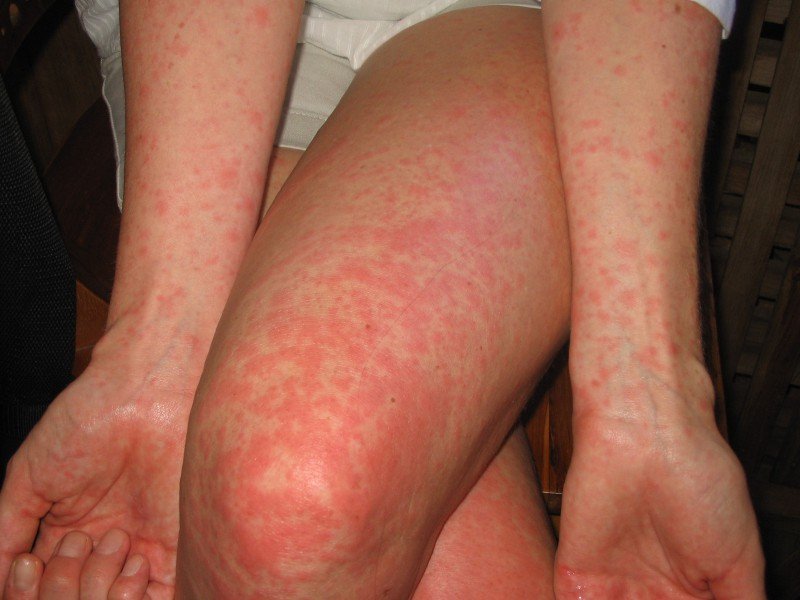
Chickenpox
The incubation period of chickenpox can last up to several weeks, and after which hyperthermia is suddenly observed, appetite disappears, the child becomes lethargic, drowsy. Characteristic red spots appear on the body, turning into severely itchy blisters. Manifestations of skin rashes are usually localized between the fingers, in the armpits, and also on the oral mucosa. During the acute period, a stable low-grade fever is maintained until recovery.
Rubella
This is a fast-flowing disease of exceptional infectiousness. A child can be a carrier of infection for a whole week from the moment of infection, while no symptoms appear. Small red spots accompanied by subfebrile temperatureoccur throughout the body. The most common localization is the baby's face, back and chest. In rare cases, rashes appear in the mouth. The disease lasts no more than 3-5 days, after which the temperature stabilizes, and the spots begin to disappear.
Scarlet fever
The causative agent of this disease is streptococcus. Scarlet fever is characterized by a severe fever, acute pain in the nasopharynx, and a small red rash that itches a lot. A favorite place for rashes is the groin, armpit... The only place on the body where there can be no stains is the area between the nose and lips. The disease lasts no more than a week, after which the condition improves significantly.
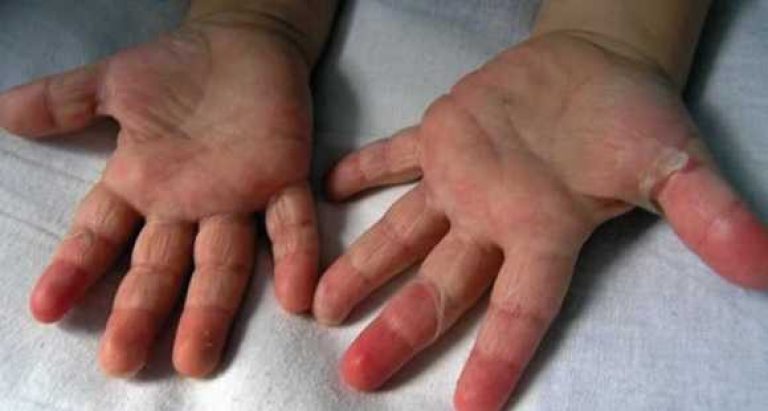
Infectious erythema
Often, the disease is diagnosed as a common ARVI, since at the onset of the disease the symptoms fully correspond respiratory disease... Starting from 2-3 days, characteristic relief dots of red color appear on the body, which merge into large spots. The rash always starts on the cheeks and then spreads to the entire body. With erythema of Chamer, the temperature always rises, which lasts the entire acute period of the disease.
Roseola
Infants are most susceptible to this ailment, but it can also be diagnosed in older children. The onset of the disease is always accompanied by fever, which recedes only for 3-4 days. After that, a pink papular rash appears on the neck, face, and limbs, which does not cause any discomfort to the child. The causative agent of the disease is the herpes virus of the sixth type.
Pseudotuberculosis
The disease in its manifestations resembles early stage traditional tuberculosis. The child develops hyperthermia, abdominal pain and joint aches. After a few days, a rash occurs, which is usually localized on the limbs. Skin manifestations last only a few days, and then the disease recedes.
Scabies
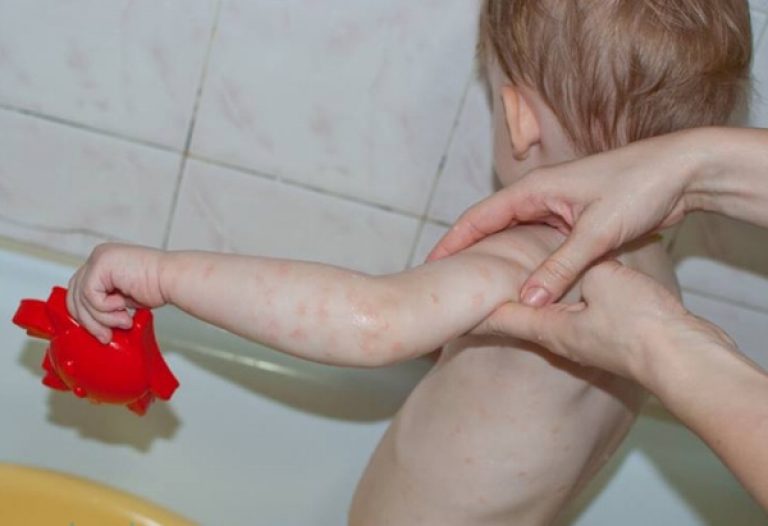
Lichen pink
The main cause of the disease is infection of the skin with a fungus. Scaly red patches form in areas of increased sweating. Lichen is usually accompanied by general weakness of the body, a slight increase in lymph nodes, hyperthermia in the evening and morning.
Molluscum contagiosum
A viral disease diagnosed in infants. Characteristic red knotted spots appear on the child's skin, which are dense to the touch. The disease is always accompanied by hyperthermia, weakness and apathy.
Allergic rash
When allergen particles enter the human body, a characteristic rash can occur, which is often accompanied by profuse tearing, sneezing, coughing and a significant increase in body temperature. A special case of the disease is urticaria. During this disease, red blisters appear on the skin, which prevent the baby from sleeping and doing his usual activities. At the onset of the disease, a strong fever may occur, which is then replaced by a low-grade fever.
The second common case of allergic rash in children is diathesis. It is believed that this is only the first stage of the allergy itself. It is characterized by the appearance of red spots on the puppies, behind the ears and on the limbs. As a rule, subfebrile hyperthermia occurs, which can lead to irritability, apathy and loss of appetite in the baby.
Rash and fever from poor hygiene
Contact dermatitis, diaper rash and prickly heat are most common in newborns. It looks like small red spots, especially in areas of increased sweating. Both ailments can be accompanied by hyperthermia, especially when the child is too wrapped. Almost always, the normalization of the microclimate in the nursery, the correct selection of clothes and hygiene procedures help to quickly cope with the problem.
Consequences of insect bites
A rash on the skin due to the bite of many species of insects is a characteristic reaction of the child's body to the toxin that enters it. They, as a rule, do not cause rashes, spots are solitary and located in completely different parts of the body. The most dangerous is the sting of a wasp and a bee, which can cause swelling, up to the development of Quincke's edema. Due to insect bites, there is often a slight increase in temperature in the affected area, which decreases rapidly.
Adults who have two symptoms at the same time, such as a high temperature (38 C and above) and a skin rash, should urgently call an ambulance. The fact is that the simultaneous appearance of a high temperature and a rash can signal a life-threatening condition. Survival is significantly higher with aggressive treatment at the onset of these difficult-to-diagnose diseases. Taken separately, skin rash and high body temperature may seem mild, but a combination of these symptoms in adults can be a sign of a serious or life-threatening illness. Survival is dramatically improved in patients who receive prompt, aggressive treatment for the underlying cause of the rash.
People often think that the rash is not a serious symptom, so treatment delays occur. However, a skin rash in combination with a high body temperature (especially in adults!) Is a clear indication of an acute systemic disease that requires further diagnosis and urgent treatment. Only early diagnosis and treatment of the disease causing the fever and rash can quickly prevent death.
Toxic shock syndrome, originally associated with tampon use in the 1980s, remains a major problem. While mortality rates associated with tampon use during menstruation have dropped to less than 5%, the rate of occurrence of toxic shock syndrome remains relatively unchanged. Cases of toxic shock syndrome in patients after surgery or trauma affect patients of all ages and genders; 3 times more likely to be fatal.
Some of the more serious conditions associated with rashes and high fever include:
Toxic shock syndrome caused by a bacterial infection
Toxic epidermal necrolysis, often caused by drug use
Staphylococcal scalded skin syndrome caused by a bacterial infection
Rocky Mountain Spotted Fever Caused by Ticks
Meningococcemia caused by a bacterial infection
Fulminant purpura, caused by thrombotic disorders
Acute toxic shock syndrome caused by a bacterial infection
These diseases are relatively rare, and their diagnosis is extremely difficult. Therefore, when symptoms such as high body temperature and rash appear, you need to quickly call an ambulance.
Children often have "mild" viral diseases that cause skin rashes and are accompanied by high fever. In adults, the combination of these symptoms requires rapid diagnosis. After all, these dangerous diseases are treatable at the earliest, most curable stages.
Another reason for rashes with fever is certain types of allergies (food, insect bites).
In children, in parallel with the rash, inflammatory process and the temperature rise.
A rash with a temperature leads to the appearance of vomiting, chills, diarrhea, migraine. Children may develop seizures and light-headedness. It is undesirable to knock the temperature down to 38 ° C, since the body itself fights the infection, but if it reaches 39 ° C and keeps at this level, you need to call an ambulance.
Etiology and symptoms
Infectious diseases
A high fever and a rash in a child most often accompany chickenpox. The disease also affects adults, but about 85% of the population get it in childhood. Typical symptoms of chickenpox:
- temperature 37-38 ° C (sometimes 39-40 ° C), which occurs even before the rash;
- vesicles with fluid on the skin of the whole body and sometimes mucous membranes;
- itching where blisters appear;
- an increase in the number of rashes, followed by their drying and crust formation;
- weakness, dizziness, headache;
- loss of appetite.
With rubella, the nature of the rash is different: these are not large pimples, as with chickenpox, but small red rashes, accompanied by all signs of acute respiratory infections (aches, runny nose, feeling unwell).
Also characteristic are pain in the eyes, aggravated by bright light, an increase in the occipital lymph nodes. The temperature lasts a couple of days. The rash spreads to the face, chest, back, and abdomen (in children).
These diseases are relatively easily transferred to childhood, but in adolescents and adults, the course is complicated.
Infection with chickenpox or rubella is especially dangerous during gestation.
The reason sharp rise fever with cough, runny nose and conjunctivitis may be less common measles. On the 3rd day, profuse rashes appear, first on the face, then on the chest, abdomen, back, arms and legs. A small rash gradually merges into spots, which for some time leave behind pigmentation and peel off.
Scarlet fever is manifested first by redness of the throat, enlargement of the tonsils, then a rash appears on the skin of the neck, the temperature rises, the nasolabial triangle becomes bluish, and the tongue becomes crimson. Itchy rashes appear on the back and chest, but there are especially many of them under the armpits, lower abdomen, inside the thighs and in the skin folds. Symptoms last for 7 days.
Infectious erythema is another "childhood" disease with symptoms similar to acute respiratory infections. A rash (red dots) occurs first on the cheekbones, gradually merging into a pattern. Such patterns then cover the entire body, swelling in places.
Herpes in babies can also cause fever, sudden temperature spikes to 39-40 ° C, and rubella-like rashes after a few days.
Another extremely dangerous pathology is meningococcal infection, accompanied by a jump in temperature, aches, and a runny nose. Pink rashes then degenerate into subcutaneous hemorrhages.
Vascular pathology
 A high fever and rash in an adult can be triggered by viral arthritis.
A high fever and rash in an adult can be triggered by viral arthritis.
The disease is accompanied by swelling and pain in the joints, head, runny nose, nausea, redness of the skin.
A person cannot move calmly.
A rash in such situations appears either due to problems with the number and functioning of platelets, or due to impaired capillary vascular permeability. Injuries or fever in various diseases lead to a rash in the form of hemorrhages.
Allergy
A variety of rashes for allergies are not uncommon, but the temperature can rise from insect bites, ingestion of allergenic food. When treating viral infections with a high fever, a rash can occur, like an allergy to a drug (such as penicillin).
Therapy
Therapy for skin rashes with fever depends on the cause of their appearance.
Some rashes with fever can go away without special treatment. For example, rubella, in the therapy of which the main thing is to provide the child with plenty of drink and place him in a darkened room.
Treatment of scarlet fever, chickenpox and other infectious diseases necessarily includes taking antibiotics. Many diseases are fraught with complications, so it is necessary to adhere to all the recommendations of a specialist and not interrupt therapy at the first improvement in the condition.
Pathologies that are not dangerous in childhood can cause great harm to the fetus if a pregnant woman falls ill.
Therefore, during the planning period for conception and gestation, contact with infected people should be avoided.
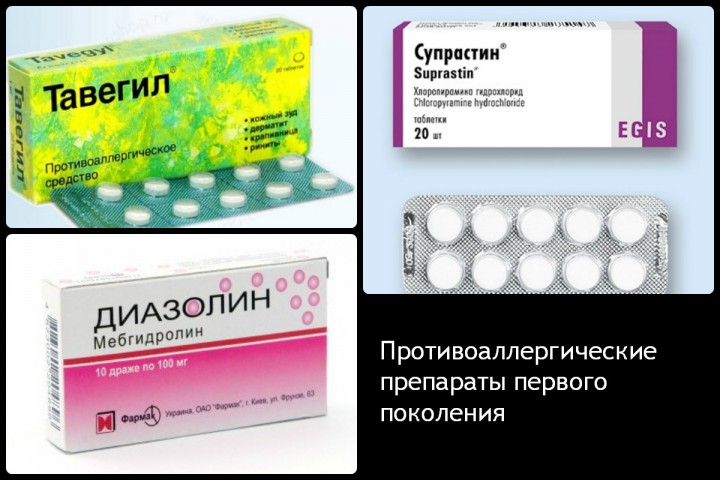 As an antipruritic agent for allergies and viral infections antihistamines are shown. It is recommended to lubricate bubbles on the skin with brilliant green, fucorcin and other drying substances. With chickenpox, it is useful to take baths with chamomile, string or manganese.
As an antipruritic agent for allergies and viral infections antihistamines are shown. It is recommended to lubricate bubbles on the skin with brilliant green, fucorcin and other drying substances. With chickenpox, it is useful to take baths with chamomile, string or manganese.
At high temperatures (38-39 ° C or more), you need to drink antipyretic.
For viral arthritis, pain relievers are indicated, sometimes clucocorticoids, bed rest. The operation is rarely performed.
Thus, there are many causes of rashes with fever and it is not always possible to accurately determine them only by symptoms. Therefore, at the first signs of pathology, you should immediately consult a doctor.
In childhood, every child has to undergo a number of infectious diseases, which in medicine are called "childhood diseases". These include: chickenpox, measles, rubella ... It is believed that it is in childhood that the body is able to more easily cope with such diseases. And among the obvious signs of most of them are specific skin rashes, which should alert parents and force them to consult a pediatrician in a timely manner. Only a doctor will be able to correctly determine the nature of the rash and make the correct diagnosis. Accordingly, adequate measures for adequate treatment will be taken in a timely manner for a particular disease.
What is a red spot on a child's skin?
But, the development of diseases does not always begin with such a symptom as a rash. Sometimes it can join 2-3 days after the onset of the disease. In this case, the first obvious signs of the disease may be as follows:
Chills,
increased body temperature
runny nose
sore throat and stomach
nausea,
vomiting
decreased appetite, etc.
Important! If red spots appear on the skin, while there are no other symptoms, in particular, the body temperature is normal, then this rather indicates a lack of hygiene.
A rash and fever most often indicate the development of diseases of an infectious or allergic nature, which requires the immediate intervention of specialists. Neglect of these symptoms can lead to a disastrous outcome.
Rubella
The first symptom of rubella is a small rash over the body. Moreover, it spreads throughout the body in a matter of hours and does not have a permanent place of localization. As a rule, it starts from top to bottom, but the greatest amount can be found on the buttock and on the bends of the legs and arms.
Measles
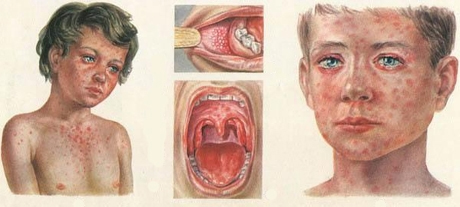 The first symptom of this infectious disease like measles - high fever, conjunctivitis, cough and stuffy nose. That is, all the symptoms that indicate a cold or flu. Only on the third day of the child begins to pour in - first on the face, because a small rash covers the child's torso, and finally the limbs. With renewed vigor, body temperature begins to rise. And as a rule, on the third day, the temperature begins to drop.
The first symptom of this infectious disease like measles - high fever, conjunctivitis, cough and stuffy nose. That is, all the symptoms that indicate a cold or flu. Only on the third day of the child begins to pour in - first on the face, because a small rash covers the child's torso, and finally the limbs. With renewed vigor, body temperature begins to rise. And as a rule, on the third day, the temperature begins to drop.
Chickenpox
With chickenpox, rashes on the body do not have a specific localization. They can even be found on the tongue. But, you can distinguish them from rashes with measles by appearance - This is a pink bubble, which at the initial stage barely protrudes above the surface of the skin. After a few hours, the bubbles increase slightly in size and fill at first. clear liquidwhich then begins to grow cloudy. As the infection subsides, the bubbles begin to dry out, and crusts appear in their place. And you need to carefully monitor the behavior of the patient, because children love to comb and peel off these crusts. 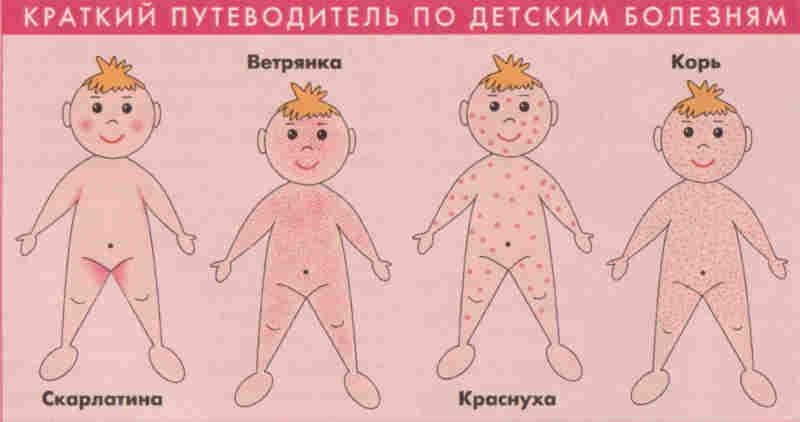
Scarlet fever
The disease differs from the previous ones in such a characteristic as severe itching. Red “poppy dots” spread throughout the body, leaving a clear area on the skin in the chin area and above the upper lip - a scarlet fever triangle.
Roseola
Roseola affects the body of newborn babies. The child's body temperature rises sharply, which begins to decrease by 2-3 days. Instead, red spots appear on the child's body and the temperature drops. Localization of spots mainly on the limbs, neck and face.
Erythema of an infectious nature
The symptoms of the initial stage of the disease are very similar to the symptoms of ARVI. Only on day 3, the first speck of bright red appears on the body. In a few hours, there are more of them, which, as they develop, begin to merge into one red spot. The place of localization of the rash is the cheeks.
Allergic rash
An allergic rash is manifested as a result of the penetration of an allergen into the body. In this case, it is very important to identify the stimulus in a timely manner and prevent its contact with the child. The temperature may rise, a runny nose and cough may appear.
Most often, parents are concerned about the question - what to do when the spots itch and flake? As a rule, with a rash on the body, the child becomes restless and this anxiety is primarily caused by severe itching. Children begin to scratch their bodies, thereby risking additional infection. Therefore, in case of rashes, you can apply a soothing compress to the skin, the basis of which can be a decoction of calendula, chamomile, celandine. In the finished broth, you need to moisten a cotton swab and wipe the affected areas of the body.
Important! Never add alcohol or drying agents to the broth, which will only aggravate the flaking of the skin.
Doctor Komarovsky about redness on the body
Children get sick often, which is what worries parents. When red spots and elevated body temperature appear on the body, this should serve as a signal for parents, who urges them to immediately show the baby to a doctor. Elevated temperature, weakness, runny nose, sore throat and a rash on the body - this is the development of some kind of disease. Which one, only the doctor determines, therefore, prescribes correct treatment... Never try to treat this kind of disease yourself, so as not to aggravate the situation. Better entrust your child to a professional.
